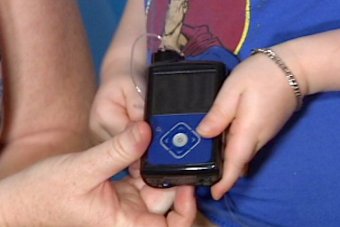An insulin pump that acts like an artificial pancreas could help a four-year-old Perth boy better manage his blood sugar levels and avoid hypoglycaemia, which can cause seizures, coma or even death.
Xavier Hames suffers from type 1 diabetes, an autoimmune disease that stops the body from being able to produce insulin, the hormone that regulates blood sugar levels, properly.
Usually diabetics need to continuously test and manage their blood sugar with finger pricks and insulin injections, but Xavier may be able to control his condition more easily thanks to his new artificial pancreas.
Although it can't yet adjust the amount of insulin delivered, the battery-operated device can tell when a patient's blood sugar levels are dangerously low and shuts off insulin production.
According to researchers from the Princess Margaret Hospital for Children in Perth, who created and installed the device, the pump can predict and prevent a hypoglycaemic attack around 30 minutes before it happens.
The majority of these attacks happen during the night, which makes them particularly dangerous.
"Most parents have to get up two or three times a night to check glucose levels and this might make them feel a little safer at night time if they know they've got this automated system that's going to prevent low glucose," Tim Jones, a professor at the hospital, told Charlotte Hamlyn for ABC News.
While the actual pump machine stay outside of the body, the insulin is delivered via a plastic tube pushed under the skin, which can last for four years before needing to be replaced.
The device is now commercially available for A$10,000, as Hamlyn reports, but the price is predicted to decrease as the technology becomes more accessible. It can also be used by any age group.
The hospital is now working on making a more sophisticated device that constantly monitors blood sugar and adjust the level of insulin delivered accordingly, which could potentially eliminate the need for finger prick testing altogether.
Over in the US, scientists are already working on a similar device, which is controlled by a smart phone. And a team of researchers have also created a temporary tattoo that monitors a patient's blood sugar levels in real time.
While all of these devices are currently going through testing, it's looking pretty hopeful that in the next decade, diabetics will have a range of options to help them better manage their condition.
Source: ABC News

